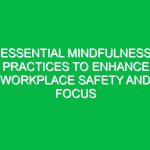“`html
Essential Mosquito Guidelines: Avoid These Risks for Your Safety
Good morning team! Today, we’re going to discuss a critical topic that impacts not only our health but also our overall safety while at work: mosquitoes. With warmer weather upon us, it’s essential to be aware of the risks associated with these pesky insects and how we can effectively avoid them. Mosquitoes are not just a nuisance; they are carriers of various diseases that can have severe consequences for our health. So, let’s dive into our essential mosquito guidelines and ensure we all stay safe.
Understanding Essential Mosquito Guidelines
Essential mosquito guidelines refer to a set of practices designed to minimize the risks associated with mosquito bites and the diseases they transmit, such as West Nile virus, Zika virus, and dengue fever. These guidelines are vital in our workplace, especially as we often work outdoors or in environments where mosquitoes thrive.
Many people mistakenly believe that mosquito bites are merely an annoyance, but the reality is that they can lead to serious health issues. Understanding these guidelines is crucial for maintaining a safe and healthy work Environment.
Key Hazards, Risks, and Safety Considerations
Let’s examine some specific Hazards and risks associated with mosquitoes:
- Health Risks: Mosquitoes can transmit diseases that may lead to severe health complications, including hospitalization or even death.
- Workplace Disruption: An outbreak of mosquito-borne illnesses can lead to increased absenteeism, impacting productivity and team morale.
- Environmental Factors: Stagnant water and dense vegetation can create breeding grounds for mosquitoes, increasing the likelihood of bites.
Ignoring safety protocols related to mosquito Prevention can lead to real-world consequences, including the potential for outbreaks within the workplace. It’s essential to stay informed and proactive in our approach to these risks.
Best Practices, Procedures, & Actionable Advice
Now that we understand the risks, let’s discuss the Best Practices and Procedures we can implement to protect ourselves from mosquito bites:
1. Wear Appropriate Clothing
When working outdoors, wear long sleeves, long pants, and socks. This clothing can help minimize skin exposure and reduce the chances of being bitten. Opt for light-colored clothing, as dark colors tend to attract mosquitoes.
2. Use Insect Repellent
Apply a mosquito repellent that contains DEET or other effective ingredients. Make sure to follow the product instructions carefully and reapply as needed, especially after sweating or being in water.
3. Eliminate Standing Water
Regularly inspect the workplace for standing water, which can serve as a breeding ground for mosquitoes. Ensure that any containers that can hold water, such as buckets and flower pots, are emptied regularly.
4. Schedule Outdoor Work Wisely
If possible, schedule work outdoors during times when mosquitoes are least active, such as early morning or late afternoon.
5. Install Screens and Barriers
Ensure that windows and doors have screens to prevent mosquitoes from entering workspaces. Consider installing barriers like nets in outdoor work areas.
6. Educate Team Members
Hold Training sessions to educate all employees about the risks of mosquito bites and the importance of these guidelines. Awareness is key to prevention.
Case Study: A Real-World Incident
A construction site in our region experienced a significant outbreak of West Nile virus due to stagnant water accumulation. Workers were not informed about the hazards of mosquito bites, resulting in multiple employees contracting the virus. This incident could have been avoided with proper education and adherence to mosquito prevention guidelines.
Regulations, Standards, and Compliance
It’s essential to be aware of the Regulations and Standards concerning mosquito control in the workplace. Organizations like OSHA have guidelines that require employers to maintain a safe working environment, which includes taking measures against pests like mosquitoes.
Compliance with these regulations is critical for protecting employees’ health. By following the essential mosquito guidelines, we not only adhere to safety standards but also demonstrate our commitment to a safe workplace.
Employee Engagement & Discussion
Now that we’ve covered the essential guidelines, I’d like to hear from you. What safety challenges have you encountered related to mosquitoes? Have you experienced any issues with mosquito bites while working? Your insights are valuable in helping us improve our safety protocols.
Conclusion & Key Takeaways
In summary, protecting ourselves from mosquito bites is crucial for maintaining our health and safety at work. Remember to:
- Wear appropriate clothing and apply insect repellent.
- Eliminate standing water around the workplace.
- Schedule outdoor tasks during low mosquito activity times.
- Educate your fellow team members about these guidelines.
By following these essential mosquito guidelines, we can create a safer work environment for everyone. Thank you for your attention and commitment to safety. Let’s prioritize our health and well-being together!
“`


